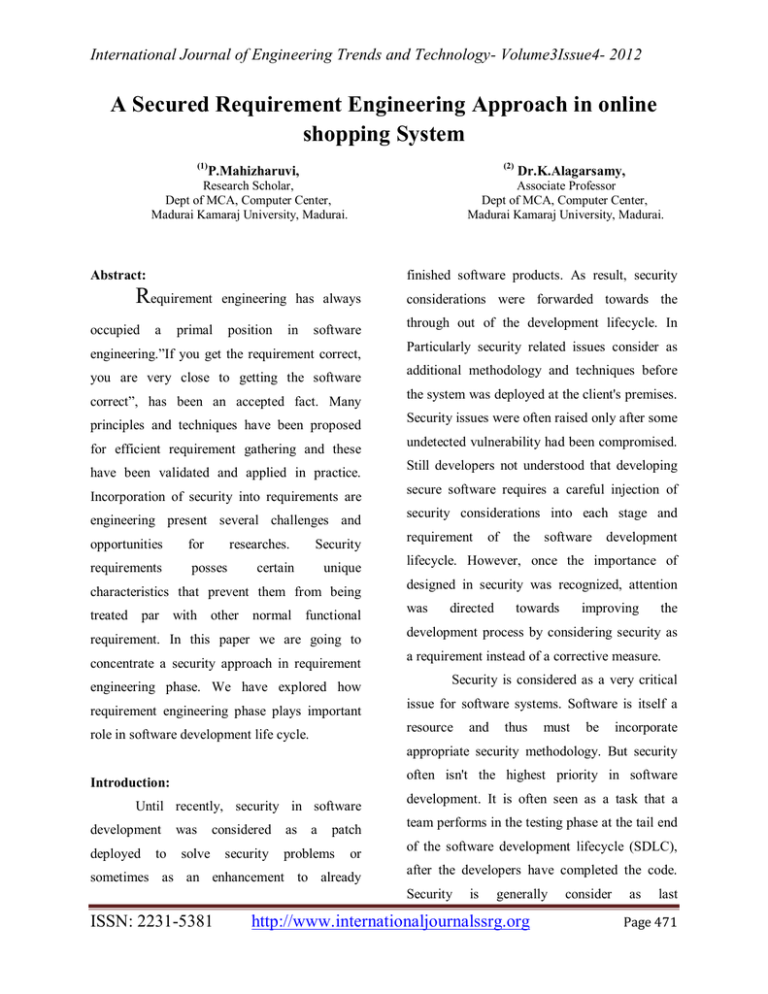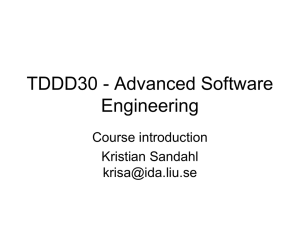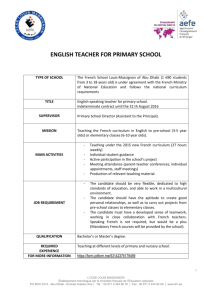Secured Requirement Engineering for Online Shopping Systems
advertisement

International Journal of Engineering Trends and Technology- Volume3Issue4- 2012 A Secured Requirement Engineering Approach in online shopping System (1) (2) P.Mahizharuvi, Research Scholar, Dept of MCA, Computer Center, Madurai Kamaraj University, Madurai. Abstract: finished software products. As result, security Requirement occupied Dr.K.Alagarsamy, Associate Professor Dept of MCA, Computer Center, Madurai Kamaraj University, Madurai. a engineering has always primal position in software engineering.”If you get the requirement correct, you are very close to getting the software correct”, has been an accepted fact. Many principles and techniques have been proposed for efficient requirement gathering and these have been validated and applied in practice. Incorporation of security into requirements are engineering present several challenges and opportunities for researches. requirements posses Security certain unique characteristics that prevent them from being treated par with other normal functional requirement. In this paper we are going to concentrate a security approach in requirement engineering phase. We have explored how requirement engineering phase plays important considerations were forwarded towards the through out of the development lifecycle. In Particularly security related issues consider as additional methodology and techniques before the system was deployed at the client's premises. Security issues were often raised only after some undetected vulnerability had been compromised. Still developers not understood that developing secure software requires a careful injection of security considerations into each stage and requirement the software development lifecycle. However, once the importance of designed in security was recognized, attention was directed towards improving the development process by considering security as a requirement instead of a corrective measure. Security is considered as a very critical issue for software systems. Software is itself a resource role in software development life cycle. of and thus must be incorporate appropriate security methodology. But security often isn't the highest priority in software Introduction: Until recently, security in software development deployed to was considered solve security as a patch problems or sometimes as an enhancement to already development. It is often seen as a task that a team performs in the testing phase at the tail end of the software development lifecycle (SDLC), after the developers have completed the code. Security ISSN: 2231-5381 is generally http://www.internationaljournalssrg.org consider as last Page 471 International Journal of Engineering Trends and Technology- Volume3Issue4- 2012 requirement i.e. given due attention only after Areas described in the SWEBOK Guide, going through all the phases of engineering a describing software. But, since the new technologies are Knowledge Area into subareas and topics. The emerging up using networking, distributed five capabilities of systems and also popularity of off Requirements, the shelf components, security issues have rather Construction, Software Testing, and Software become most important. Security should be Maintenance. However, here the term security considered as an important part of all phases has been highlighted throughout the Guide, and during the software development lifecycle terms like secure software requirements, secure (SDLC). Also it has been derived that if security software design, secure software construction, is implemented right from the origin of software, secure software testing, and, finally, secure it saves the economy billions of dollars. Concern software maintenance have been added. is thus in need of a model to examine security Software Requirements and Secure Software and quality requirements in the development Requirements the decomposition Knowledge Areas Software of are: each Software Design, Software stages of the production lifecycle. Software that In the software requirements phase [2], is developed with security in mind is typically the students are able to define the requirements more resistant to both intentional attack and as properties brute force attacks and failures. However, it is problem. Within the first two sub areas, incredibly hard to show that a particular system “Software Requirements Fundamentals” and is 100% secure. Presently, there is no single “Requirements Process,” the students learn solution engineering. about the definitions of software requirements as However, there are specific approaches which well as the major types of requirements: product improve the likelihood that a system is secure. vs. process and functional vs. nonfunctional. The security of software is threatened at various Students will learn to describe process models, points throughout its life cycle, both by process inadvertent and intentional choices and actions management, taken by insiders. improvement. for secure software that solve some real-world actors, process and The process second support and quality and sub area, “requirement process,” will introduce students to the Related works: first guideline on securing software The current SWEBOK Guide [2] can requirements, which is negotiating trade-offs serve as a reference for a secure software that are both acceptable to the principal engineering course. The course overview is stakeholders and within budgetary, technical, illustrated in Figure 1. The breakdown of the regularity, and other constraints, that is because course constitutes the same first five Knowledge it will not be possible to perfectly satisfy the ISSN: 2231-5381 http://www.internationaljournalssrg.org Page 472 International Journal of Engineering Trends and Technology- Volume3Issue4- 2012 requirements of every stakeholder. The second Requirements analysis includes guideline covers the link between the process classification, conceptual modeling, architectural activities identified in the process models and design, and allocation of requirements, as well the issues of costs, human resources, training, as requirements negotiation. Students learn and tools. The third guideline covers the many improvement of the requirements process by requirements that assist in understanding issues using standards and models in terms of the cost associated with modeling entities from the and timeliness of a software product and of the problem domain configured to reflect their real- customer’s satisfaction with it. world relationships and dependencies. The practical ways to secure software SWEBOK guide provides many examples of conceptual modeling, such as UML, formal modeling, IEEE Std 1320.1 for functional modeling, and IEEE Std 1320.2 for information modeling. Moreover, it refers to IEEE Std 14712000 for recommended practices for describing the architectural aspects of software-intensive systems. This standard suggests a multipleviewpoint approach to describe the architecture The third sub area, “requirements elicitation,” is concerned with where software of systems and their software items. The fifth sub area, “requirements requirements come from and how the software specification,” typically refers to the production engineer of a document, can collect them. It includes requirement sources and elicitation techniques. or its electronic equivalent, that can be Learning these by themselves are practical systematically guidelines that enhance the above proposed approved. The general rule is that notations guidelines should be used that allow the requirements to be such as interviews, scenarios, reviewed, evaluated, and and described as precisely as possible. This rule observations. The fourth sub area, “requirements serves as a guideline for students to consider in analysis,” is concerned [2] with the process of writing the software requirements specification analyzing requirements in order to detect and document, keeping in mind a number of quality resolve conflicts between them and discover the indicators. prototypes, facilitated meetings bounds of the software and how it must interact with its environment. IEEE 1465 is a standard treating quality requirements in software packages. Students are ISSN: 2231-5381 http://www.internationaljournalssrg.org Page 473 International Journal of Engineering Trends and Technology- Volume3Issue4- 2012 also introduced to IEEE Std 830 for the production and content of the software requirements specification. In addition, the last two sub areas, [2] which are “requirements Proposed Algorithms steps: validation” and “practical considerations,” can be taught to students as security guidelines and 1. System has to give a authorization for practices. Many security vulnerabilities in every user whose logged into the system software can be avoided if students are better 2. System has to identify the permission of equipped to recognize the security implications of their requirements choices. In requirements validation, they examine the requirements documents to ensure that they are defining the right system. Requirements validation is subdivided into descriptions of the conduct of requirements reviews, prototyping, and model validation and acceptance every user and access rights. 3. System can able to trace back the users logs and transactions 4. System tolerates the vulnerabilities and common virus attacks 5. System has to protect the data from the intruders 6. Security patterns identification 7. Security package identification Proposed work: In software development life cycle Now take a small example of online requirement engineering phase is one of the purchasing website or e commerce business. We important phases, which gives the proper have applied our algorithm to develop the objectives, requirements, goals of customer. If software product for online hoping. While we have identified the correct requirements end constructing the software product we should product will be a desired one thing, in case any focus many things in terms of security aspect in problem occur in this part once again we have to the requirement phase itself. revert the process. Many of the software transaction lot of vulnerabilities there like virus, researchers are working security model as spam, hacking, intruders, etc. End product separate part of development or end of should tolerate the miscellaneous activities. We development but this kind of approach leads to have implemented our security algorithm in this problematic security software development which yields the better enhancement part becomes a question mark in result than normal developments model and also software requirement engineering phase. In this we made comparison analysis between ISDF paper we have discussed some ideas to develop frame work [3] security approaches. one thing. Still In online the requirement engineering phase. ISSN: 2231-5381 http://www.internationaljournalssrg.org Page 474 International Journal of Engineering Trends and Technology- Volume3Issue4- 2012 [3] The ISDF Framework: Towards Secure Software Development- Abdulaziz Alkussayer and William H. Allen. [4] Nancy R. Mead, T. Stehney. “Security Quality Requirements Engineering (SQUARE) Methodology”. ISDF Proposed Software Engineering for Secure Systems – Building Algorithm Trustworthy Applications (SESS'05), 2005 [5] G. McGraw. “Software Security, Building Security”. In Traceability 73.56 85.12 Attacks 65.12 87.45 published by IEEE Computer Society, 2004 [6] CERT's podcasts: Security for business leaders: Show Tolerability notes. Retrieved January 31, 2010, from CERT Podcast Trace back 79.98 92.67 Series http://www.cert.org/podcast/notes/20080304cappelli- Table 1 notes.html Conclusion: In modern world everything becomes an online solution like online banking, online purchase, etc. But it opens the door for lot of security related problem. To avoid this we have worked with the software development models especially in requirement engineering phase and also we have developed a novel security approach in software development model to enhance the productivity of the software development model requirement engineering phase. According to our algorithmic approach we have yielded good result over the existing methodology. It is our trust this will help to online business mans and merchants. References: [1] Cutting Edge Practices for Secure Software Engineering- Kanchan Hans Amity Institute of Information Technology Amity University, Noida, [2] Secure Software Engineering: A New Teaching Perspective Based on the SWEBOK Manar Abu Talib ,Zayed University, Abu Dhabi, UAE Adel Khelifi Al Hosn University, Abu Dhabi, UAE Leon Jololian Zayed University, Abu Dhabi, UAE ISSN: 2231-5381 http://www.internationaljournalssrg.org Page 475


